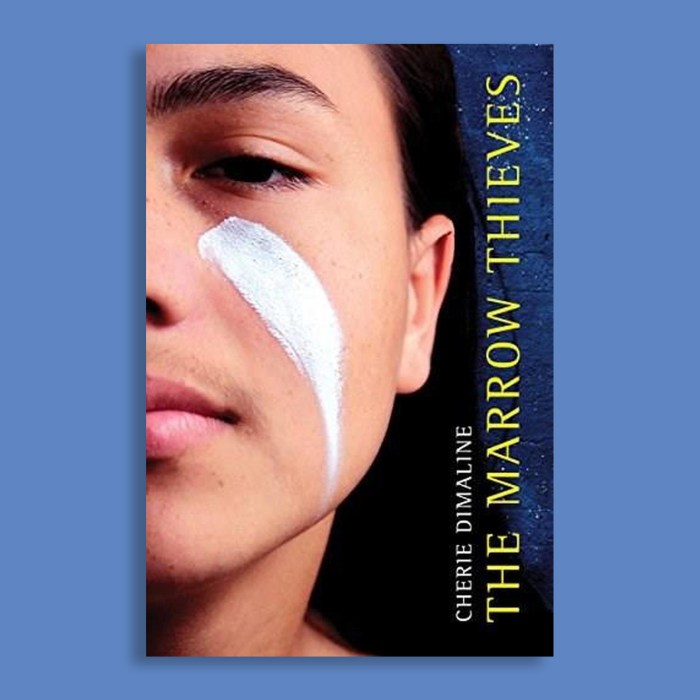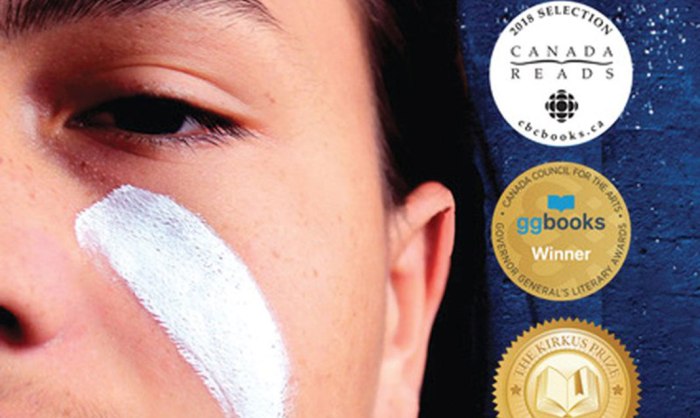Literary devices in the marrow thieves – In Cherie Dimaline’s captivating novel, The Marrow Thieves, literary devices play a pivotal role in crafting a narrative that explores the themes of power, identity, and resilience. Through the use of symbolism, imagery, foreshadowing, irony, and metaphor, Dimaline immerses readers in a world where Indigenous youth are hunted for their bone marrow, which holds the power to cure a deadly disease.
The novel’s intricate use of literary devices not only enhances the storytelling but also provides profound insights into the characters’ experiences, the complexities of oppression, and the enduring strength of the human spirit.
Symbolism

The marrow in The Marrow Thievesis a powerful symbol of resilience and resistance. The marrow is a source of life and vitality, and the marrow thieves’ ability to steal dreams represents their attempt to extinguish the spirit of the Indigenous people.
The marrow is also a metaphor for the Indigenous people’s connection to their land and culture. The marrow is taken from the bones of the caribou, which are a sacred animal to the Indigenous people. The marrow thieves’ act of stealing the marrow is a symbolic act of desecration and dispossession.
The Marrow Thieves’ Ability to Steal Dreams
The marrow thieves’ ability to steal dreams is a particularly potent symbol of their power. Dreams are a source of hope and inspiration, and the marrow thieves’ ability to steal them represents their attempt to crush the spirit of the Indigenous people.
Imagery

The Marrow Thievesis filled with vivid imagery that creates a sense of place and time. The novel’s setting is a dystopian future where the Indigenous people are hunted for their marrow. The imagery of the novel reflects the harsh and unforgiving world that the characters live in.
The novel also uses imagery to create a sense of atmosphere and tone. The novel’s opening scene is particularly effective in this regard. The scene describes the marrow thieves’ raid on a group of Indigenous people. The imagery of the scene is brutal and violent, and it sets the tone for the rest of the novel.
Imagery of Place and Time
The imagery of The Marrow Thievescreates a strong sense of place and time. The novel is set in a dystopian future, and the imagery of the novel reflects the harsh and unforgiving world that the characters live in.
- The novel’s setting is described in detail, and the imagery of the novel helps to create a vivid sense of place.
- The novel also uses imagery to create a sense of time. The novel is set in a dystopian future, and the imagery of the novel reflects the harsh and unforgiving world that the characters live in.
Foreshadowing

Foreshadowing is used throughout The Marrow Thievesto create suspense and build tension. The novel’s opening scene foreshadows the violence that is to come. The scene describes the marrow thieves’ raid on a group of Indigenous people. The imagery of the scene is brutal and violent, and it sets the tone for the rest of the novel.
The novel also uses foreshadowing to hint at the characters’ fates. For example, the novel foreshadows the death of one of the main characters. The character is described as being “marked for death,” and the reader is given several clues that the character will not survive.
Suspense and Tension, Literary devices in the marrow thieves
Foreshadowing is used throughout The Marrow Thievesto create suspense and build tension. The novel’s opening scene foreshadows the violence that is to come. The scene describes the marrow thieves’ raid on a group of Indigenous people. The imagery of the scene is brutal and violent, and it sets the tone for the rest of the novel.
- The novel also uses foreshadowing to hint at the characters’ fates. For example, the novel foreshadows the death of one of the main characters. The character is described as being “marked for death,” and the reader is given several clues that the character will not survive.
Irony
Irony is used throughout The Marrow Thievesto create humor, suspense, and tension. The novel’s title is ironic, as the marrow thieves are actually stealing the dreams of the Indigenous people. This irony is highlighted in the novel’s opening scene, when the marrow thieves raid a group of Indigenous people and steal their dreams.
The novel also uses irony to create suspense and tension. For example, the novel foreshadows the death of one of the main characters. However, the character’s death is ultimately ironic, as it is caused by the very people that the character was trying to help.
Humor, Suspense, and Tension
Irony is used throughout The Marrow Thievesto create humor, suspense, and tension. The novel’s title is ironic, as the marrow thieves are actually stealing the dreams of the Indigenous people. This irony is highlighted in the novel’s opening scene, when the marrow thieves raid a group of Indigenous people and steal their dreams.
- The novel also uses irony to create suspense and tension. For example, the novel foreshadows the death of one of the main characters. However, the character’s death is ultimately ironic, as it is caused by the very people that the character was trying to help.
Metaphor: Literary Devices In The Marrow Thieves
Metaphors are used throughout The Marrow Thievesto create vivid imagery and convey complex ideas. The novel’s title is a metaphor, as the marrow thieves are actually stealing the dreams of the Indigenous people. This metaphor is highlighted in the novel’s opening scene, when the marrow thieves raid a group of Indigenous people and steal their dreams.
The novel also uses metaphors to convey complex ideas. For example, the novel uses the metaphor of the “dreamcatcher” to represent the Indigenous people’s connection to their culture and traditions.
Vivid Imagery and Complex Ideas
Metaphors are used throughout The Marrow Thievesto create vivid imagery and convey complex ideas. The novel’s title is a metaphor, as the marrow thieves are actually stealing the dreams of the Indigenous people. This metaphor is highlighted in the novel’s opening scene, when the marrow thieves raid a group of Indigenous people and steal their dreams.
- The novel also uses metaphors to convey complex ideas. For example, the novel uses the metaphor of the “dreamcatcher” to represent the Indigenous people’s connection to their culture and traditions.
FAQs
What is the significance of the marrow in the novel?
The marrow symbolizes the power and resilience of Indigenous youth. It is a source of healing and strength that the marrow thieves seek to exploit.
How does foreshadowing contribute to the novel’s impact?
Foreshadowing creates suspense and builds tension, hinting at the dangers that lie ahead for the characters. It also foreshadows the novel’s ultimate message of hope and resilience.
What role does irony play in the novel?
Irony is used to highlight the novel’s themes and create a sense of tension. For example, the fact that the marrow thieves are themselves victims of a deadly disease adds a layer of irony to their actions.